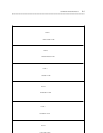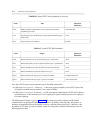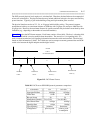COMMUNICATIONS PROTOCOLS D-11
_ ______________________________________________________________________________________
_ ______________________________________________________________________________________
_ ______________________________________________________________________________________
• The Bell standard for X.25 (BX.25)
The primary rate interface standard is the ISDN standard for communication along a DS1 facility. AT&T
has its own implementation of this standard. For further details, see the DEFINITY Communications System
Generic 2 and System 75 and System 85 DS1/DMI/ISDN PRI Reference manual (555-025-101).
The basic rate interface standard is the ISDN standard for line side communication. For the AT&T
implementation of this standard, see the DEFINITY Communications System Generic 2 and System 75 and
System 85 ISDN BRI Reference manual (555-025-102).
Digital Multiplexed Interface
Digital Multiplexed Interface (DMI) protocol is a standard that defines communications along a DS1
facility. AT&T created this protocol in anticipation of an ISDN standard for the primary rate interface
(PRI). Unlike the ISDN-PRI standard, which designs the communications path around 23 B (bearer)
channels of 64 kbps and one D (signaling) channel of 16 kbps, however, the DMI standard calls for 24
channels of 64 kbps, each. Communications along PRI B channels are conducted according to the DMI
standard. For further details, see the DEFINITY Communications System Generic 2 and System 75 and
System 85 DS1/DMI/ISDN PRI Reference manual (555-025-101), and the Digital Multiplexed Interface
[DMI] Technical Specification, Issue 3.2 (555-025-204).
Data Modes
DMI facilities transmit information in any of four modes — 0 through 3. Each mode is described in detail
below. Besides formatting the transmitted information into one of these modes, DMI endpoints follow a
convention in determining which mode is appropriate for a transmission.
Given in their order of preference, the following are five methods of determining the mode required for a
call:
1. Using message-oriented signaling (MOS) at both ends of the call
2. Using adaptive procedures at the endpoints for determining the mode of operation of the calling
endpoint.
3. Administering endpoints by assigning certain directory numbers to specific modes.
4. Administering channels by assigning certain channels to operate only in specific modes.
5. Using the mode-2 in-band handshake message to establish the final transmission mode.
Data Mode 0
Capabilities:
—64 kbps (DS0 rate)
—Full-duplex operation
—Synchronous transmission of user data (slave timing)


















